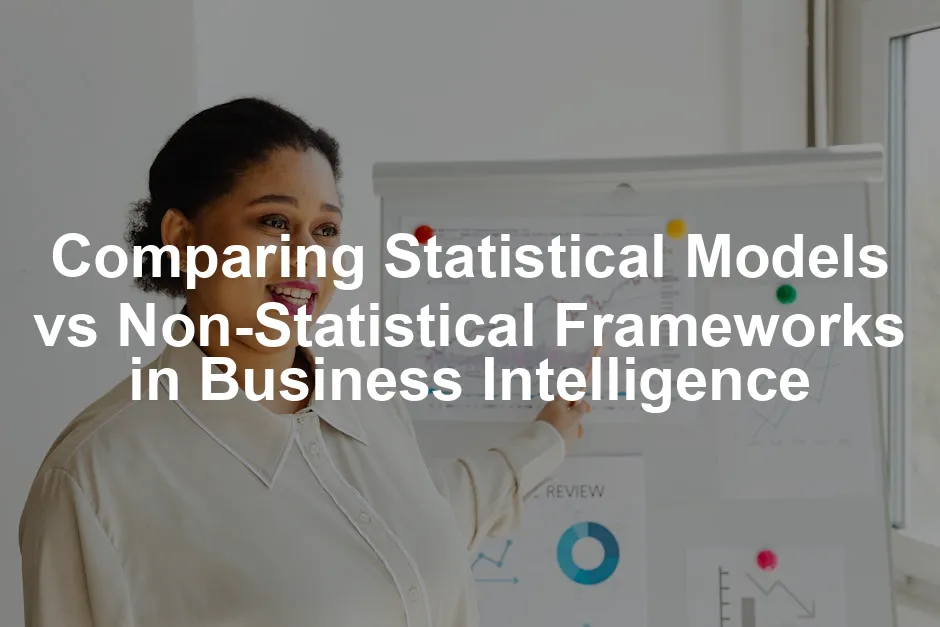Introduction
In the world of business intelligence (BI), choosing the right analytical framework can feel like navigating a maze. Should you opt for traditional statistical models that promise reliability and clarity or dive into the realm of non-statistical frameworks that boast flexibility and predictive power? It’s like choosing between a well-worn map and a state-of-the-art GPS—each has its merits, but the best choice depends on the journey ahead. This article unpacks the key differences, advantages, and applications of statistical models and non-statistical frameworks in BI, helping you make an informed decision for your business needs.
Summary
The debate between statistical models and non-statistical frameworks in business intelligence is not just academic; it’s a critical consideration for organizations seeking effective data-driven decisions. Statistical models, rooted in established theories and assumptions, provide clarity and interpretability, making them ideal for hypothesis testing and understanding relationships between variables. They shine in smaller datasets where detailed insights are paramount.
Speaking of insights, if you’re diving into the world of data science, you might want to check out “Data Science for Business” by Foster Provost and Tom Fawcett. This book is essential for understanding how data science can drive business decisions and strategies. It’s like having a trusted guide in that maze we just talked about!
Statistical models are essential for effective hypothesis testing in business intelligence. Learn more about hypothesis testing.
In contrast, non-statistical frameworks, like machine learning models, leverage vast datasets to uncover patterns and make predictions without the constraints of strict assumptions. They excel in environments where large-scale data is available and predictive accuracy is the priority. However, they often lack the transparency that many organizations desire. The choice between these approaches depends on several factors, including the size of your data, the need for interpretability, and your specific business objectives. In the following sections, we will analyze each of these frameworks, comparing their methodologies, applications, and advantages to help you navigate this crucial decision.

Statistical Models in Business Intelligence
Definition and Purpose
Statistical models are mathematical frameworks used to analyze data. They help organizations understand relationships between different variables. By relying on established theories, these models provide a structured way to interpret data. Their primary goals include hypothesis testing and inferring relationships, making them ideal for researchers and analysts alike. Statistical models can clearly show how one variable influences another, allowing for informed decision-making.
Types of Statistical Models
Statistical models can be classified into parametric and nonparametric models. Parametric models, like linear regression, assume a specific data distribution. They are particularly effective for predicting continuous outcomes. Nonparametric models, such as decision trees, do not rely on strict assumptions about data distribution. They are versatile and can handle various types of data, making them suitable for classification tasks. If you want to dive deeper into linear regression, consider checking out the Linear Regression Analysis Kit. It’s a great way to get hands-on with regression analysis!
Applications and Use Cases
Statistical models find applications in many industries. In finance, they can forecast stock prices based on historical data. Healthcare institutions use them to assess patient risks and optimize treatment plans. Retail businesses apply statistical models to predict customer preferences, helping to tailor marketing strategies. These examples illustrate that despite their limitations in handling large datasets, statistical models excel in providing detailed insights and establishing clear relationships between variables.

Non-Statistical Frameworks in Business Intelligence
Definition and Purpose
Non-statistical frameworks encompass a range of methodologies, primarily focusing on predictive analytics. These frameworks utilize machine learning and data mining techniques that do not rely on traditional statistical assumptions. Their primary aim is to uncover hidden patterns in data and make accurate predictions. By leveraging vast amounts of data, non-statistical frameworks can identify trends that might be missed by their statistical counterparts. To enhance your understanding of machine learning, grab a copy of “Machine Learning Yearning” by Andrew Ng. This book will help you understand how to structure machine learning projects effectively!
Types of Non-Statistical Frameworks
Non-statistical frameworks can be divided into supervised and unsupervised learning models. Supervised learning uses labeled data to train algorithms, enabling them to classify or predict outcomes. In contrast, unsupervised learning analyzes unlabeled data to discover hidden patterns without predefined categories. This flexibility makes non-statistical frameworks particularly valuable in scenarios where data is abundant and complex.

Applications and Use Cases
Industries across the board benefit from non-statistical frameworks. For instance, in finance, machine learning models can detect fraudulent activities by analyzing transaction patterns. In marketing, these frameworks can segment customers based on behavior, allowing for targeted campaigns. The healthcare sector employs them to predict disease outbreaks by analyzing vast datasets from various sources. These examples highlight that while non-statistical frameworks may lack transparency, their ability to process large volumes of data makes them indispensable in today’s data-driven landscape.

Comparing Statistical Models and Non-Statistical Frameworks
Key Differences
When comparing statistical models and non-statistical frameworks, it’s essential to consider their different objectives. Statistical models focus on interpretation and inference, while non-statistical frameworks prioritize prediction and pattern recognition. Statistical models provide clear insights into relationships between variables, whereas non-statistical models excel at handling complex, high-dimensional data without predefined assumptions.

Data Requirements
Data size and complexity significantly impact the effectiveness of each approach. Statistical models generally perform better with smaller datasets, where relationships can be clearly established. In contrast, non-statistical frameworks thrive in large-scale environments, leveraging vast amounts of data to enhance predictive accuracy. This scalability advantage makes non-statistical approaches increasingly popular in industries generating massive data volumes. If you’re curious about diving deeper into data mining, consider the “Data Mining Concepts and Techniques” Book. It’s a comprehensive guide to help you navigate this field!
Advantages and Disadvantages
Statistical models offer strengths such as interpretability and simplicity, making them ideal for situations where understanding relationships is critical. However, they often struggle with scalability and may not capture complex patterns. Non-statistical frameworks, on the other hand, provide flexibility and high predictive accuracy but can be challenging to interpret and understand. This lack of transparency can be a drawback for organizations seeking to explain their decision-making processes.
In conclusion, the choice between statistical models and non-statistical frameworks ultimately depends on your specific business needs, data characteristics, and desired outcomes. Understanding these differences will empower organizations to select the most suitable analytical methods for their business intelligence strategies.

Choosing the Right Framework for Your Business
Factors to Consider
Business Objectives
When selecting between statistical and non-statistical frameworks, it’s crucial to align with your business goals. If your primary aim is to understand relationships between variables, statistical models are your best bet. They excel in hypothesis testing and provide clear insights. For example, a healthcare organization might use statistical models to determine how different treatments affect patient outcomes. On the other hand, if your focus is on predictive power and flexibility, non-statistical frameworks, like machine learning, should be your go-to. These frameworks thrive in environments where anticipating trends is key, such as in retail forecasting.
Another consideration is the level of interpretability required. If stakeholders need clear explanations of how decisions are made, statistical models provide that clarity. However, if the priority is on achieving the highest possible accuracy, non-statistical models might be more suitable, even if they lack transparency. Understanding your organization’s decision-making style can greatly influence which framework you choose.
Data Characteristics
Data plays a pivotal role in deciding between statistical models and non-statistical frameworks. The size, complexity, and type of data you handle can dictate the most effective approach. Statistical models generally perform best with smaller, structured datasets. They rely on clearly defined relationships and assumptions about the data, making them ideal for exploring straightforward questions. A classic example would be a small financial dataset used to assess the impact of interest rates on consumer spending. You can also enhance your data analysis skills with “Python for Data Analysis” by Wes McKinney. It’s an excellent resource for mastering data manipulation!
Conversely, non-statistical frameworks are designed to handle large, complex datasets. They thrive in situations where data is unstructured or has many variables. For instance, an e-commerce company might utilize machine learning to analyze customer behavior across millions of transactions, identifying purchasing patterns that statistical models might miss. It’s essential to assess your data’s characteristics—its volume, variety, and velocity—to determine the most suitable analytical framework.
When evaluating the right framework, consider conducting a pilot study. This can help you understand how each approach interacts with your data. Analyze the outcomes and see which model aligns better with your goals. Ultimately, the chosen framework should reflect both your strategic objectives and the nature of your data.

Case Studies
Let’s delve into some real-world scenarios where companies successfully implemented either statistical models or non-statistical frameworks, demonstrating their outcomes and lessons learned.
A retail giant, using statistical models, aimed to optimize its inventory. By applying linear regression analysis, they assessed how seasonal trends influenced sales across various product categories. The model revealed significant relationships between promotional activities and sales spikes during holidays. With these insights, the company fine-tuned its inventory management, resulting in a 20% reduction in overstock and a corresponding increase in customer satisfaction due to better product availability.
In another case, a healthcare provider turned to non-statistical frameworks to tackle patient readmission rates. By utilizing machine learning algorithms, they analyzed thousands of patient records to identify hidden patterns linked to readmissions. The model uncovered complex interactions between various factors, such as treatment plans and social determinants of health. As a result, the organization implemented targeted interventions, leading to a 15% decrease in readmissions and a significant cost savings. If you want to learn more about healthcare analytics, check out “Healthcare Analytics Book” for deeper insights!
Additionally, a technology firm employed a hybrid approach, combining both models. They used statistical models for initial hypothesis testing, assessing user engagement metrics. Once they established significant relationships, they transitioned to machine learning to predict future trends based on user behavior. This strategic blend allowed them to refine their product features, ultimately boosting user retention rates by 30%.
These case studies illustrate that the choice of framework can have a profound impact on business outcomes. By understanding their specific needs and leveraging the strengths of each approach, organizations can drive meaningful results and foster data-driven cultures.

FAQs
What are the main differences between statistical models and machine learning?
Statistical models focus on understanding relationships and making inferences about data. Machine learning, however, excels at making predictions and finding patterns in large datasets without strict assumptions.
When should I use statistical models over non-statistical frameworks?
Opt for statistical models when interpretability is crucial, and you need to understand relationships between variables clearly. They are ideal for smaller datasets where detailed insights are essential.
Can I combine both approaches in my BI strategy?
Absolutely! Integrating both statistical and non-statistical methods can provide a comprehensive analytical approach. Use statistical models for hypothesis testing and non-statistical frameworks for making predictions based on larger datasets. This synergy can enhance your overall data-driven strategy and foster better decision-making.
Please let us know what you think about our content by leaving a comment down below!
Thank you for reading till here 🙂
All images from Pexels




